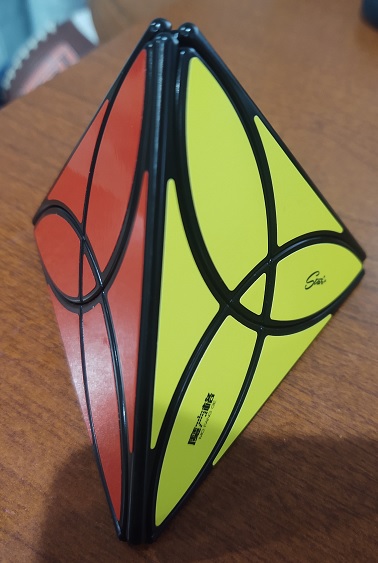

At first glance, this puzzle doesn't look like it's going to be very interesting at all, but I was pleasantly surprised! It's quite cleaver and has some interesting cases. According to a website, it was invented by Yukang Wu, whoever that guy is.
With one side of the tetrahedron on a table and one side facing you, two sides face away
from you. The left edge we'll denote with L, the right, R, and
the edge behind, B. We will have no need to refer to the remaining 3 edges
resting on the table. Of course, after re-orienting the puzzle, the edges L,
R and B reassign. Every edge can turn 90 degrees, and the puzzle
does not bandage. Though it's not immediately obvious, you can convince yourself that
the puzzle has a 3x3x3 core.
There are some fun parts to this puzzle. You have the tiny face triangles which are dualed, if you will, by an internal kind of spikey "face" piece that hides behind the leaf peices. And then there are, of course, the edge peices. The internal "faces" or spikes are hidden when the puzzle is in the solved state, and the tiny triangle face pieces can become hidden too. The whole puzzle shape-shifts in really cool ways.
We will use |U| to denote a rotation of 120 degrees of the puzzle about
an axis that sticks up from the table and orthogonal to its surface. Looking down at
the table from above, this is a clock-wise rotation. Of course, |U'| would
denote a counter-clock-wise rotation of the puzzle. Once the puzzle is rotated, the meaning
of L, R and B changes due to the new orientation.
Get the puzzle back into tetrahedral shape.
Start rotating just the edge pieces so that they, regardless everything else, form the edges of a tetrahedron. Interestingly, if you don't pay attention to color at this step, you can get the whole puzzle back into tetrahedral shape, but once you do, you won't be able to finish the solve. So make sure the edges are oriented properly with respect to one another, with regard to both shape and color.
Use X=R',L,R,L' to swap the pair of faces pieces, one right in front of you,
the other inside the top vertex. Either face piece could be a tiny triangle or an internal
spikey "face" piece. You want to involve both kinds in the swap, because your goal is to move
all the kinds of face pieces around so that they're in their proper places relative to the
edges. The internal spikey "face" pieces should be at the vertices of the tetrahedron, while
the tiny triangle face pieces should be in the center of the faces of the tetrahedron.
A tricky case can happen where a said swap solves one pair, but then unsolves another. You may have to move some stuff out of the way, do the swap, and then restore.
Note that an interesting case occurs near the end of the solve that is due to an ambiguity in this step, which is simply that it is not clear which internal spikey "faces" should be at which vertices. Swapping pairs of such "faces" creates or destroys a parity error at the last step of the solve. (This is the classic "it can't be solved by tri-cycles" problem, because a swap is needed.) Anyhow, just be aware of that. There's no obvious way I know of as for how to account for it at this step. If you encounter the parity error near the end of the solve, then, interestingly, a backtrack won't be needed, as is often the case with other puzzles.
Once all faces are positioned, use 2X to flatten the pedals.
This move will flatten a pedal in the front face at top/center, and a pedal in
the back/left face at top/center as well. Don't worry about preserving the edge
orientations at this stage, provided you move them in multiples of 180 degrees, not 90.
You can also use 2X' to flatten similarly with pedals in the front and back/right
faces. Your choice of 180 degree turns of all the edges prepare you for applications of
2X or 2X' to get all the pedals flattened.
Once this step is complete, the puzzle is back in tetrahedral shape.
Get all faces of the tetrahedron to be one color.
Restore the proper edge orientations, respecting colors of the edges. In other words, just resolve the edges. Super quick and easy.
Move the pedals into position, using setups as needed. I use two sequences for this.
The first is 2X,|U'|,2X, which rotates the 3 pedals covering
the internal spikey "face" for the top vertex of the tetrehadon (as it rests on a table.)
The pedals rotate clock-wise when viewing the vertex from above. Of course, this is
a tri-cycle.
The second is the trivial tri-cycle 2[L,R]. It's easy to see exactly
which 3 pidals this tri-cycles/rotates.
Of course, it's also good to know how to peform these tri-cycles in the opposite
directions, and of course, it's just the inverses 2X',|U|,2X' and
2[R,L].
You'll find that you may need to use one of these as a setup move for the other. Some setups need to be a bit more elaborate to get all the pudals solved.
Lastly, solve the tiny triangle face pieces. A tri-cycle for them is
2[L,R],B,(2[L,R])',B'. Memorizing the inverse is helpful too.
As was said earlier, you can run into a problem here where the puzzle doesn't solve,
because the remaining unsolved faces are a pair, which, of course, can't be tri-cycled
into position. This is the afformentioned pairty error. To solve it, just use
3X three times to swap a pair of internal spikey "faces". Now you can
tri-cycle the remaining unsolved tiny triangle faces using tri-cycles.
Even better, I just found B,3[R,'L,R',L],B' which solves the parity out-right.